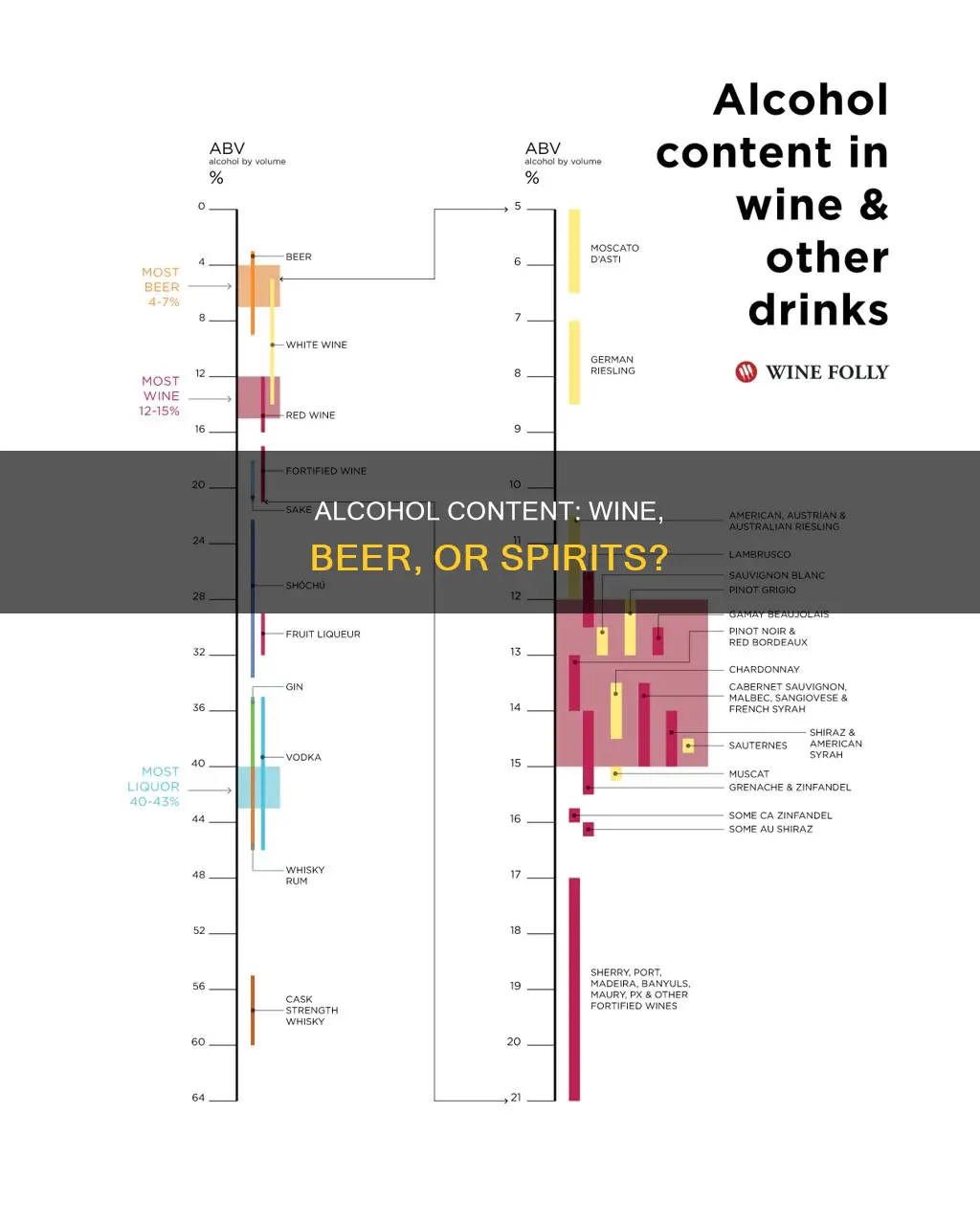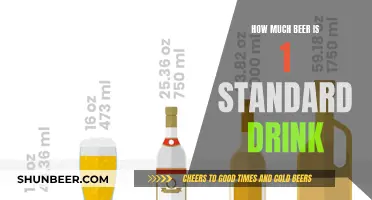
Alcohol is a beverage made from fermented grains or fruit and has been consumed by humans for at least 10,000 years. While there are many kinds of alcohol, the types are standardized to beer, wine, and liquor in the United States. Despite common misconceptions, standard serving sizes of all alcoholic beverages are equal in alcohol strength and effect on the body. This means that a typical serving of beer, wine, or spirits contains the same amount of alcohol. However, the percentage of alcohol by volume (ABV) can vary within and across beverage types, and understanding these differences is crucial for responsible drinking and avoiding alcohol abuse.
| Characteristics | Values |
|---|---|
| Average alcohol content of beer | 3% to 7% ABV |
| Average alcohol content of wine | 9% to 14% ABV |
| Average alcohol content of spirits | 20% ABV and above |
| Standard serving size of beer | 12 oz |
| Standard serving size of wine | 5 oz |
| Standard serving size of spirits | 1.5 oz |
What You'll Learn

Beer, wine, and spirits all have the same amount of alcohol per serving
It's a common misconception that different alcoholic drinks have different alcohol strengths and effects on the body. However, this is not the case. In the US, a standard serving of any alcoholic beverage—be it beer, wine, or liquor—is considered equal in alcohol strength and its effect on the body.
According to the Dietary Guidelines for Americans, published by the US Departments of Health and Human Services and Agriculture, a drink of alcohol is defined as "12 oz. of regular beer, 5 oz. of wine, and 1.5 oz. of 80-proof distilled spirits." Each of these standard servings contains roughly 0.6 oz of alcohol, or 14 grams, which is considered one alcoholic drink equivalent.
Beer typically contains between 4% and 7% alcohol by volume (ABV), with an average of 5% ABV. A standard serving of beer is 12 oz, which equates to 0.6 oz of alcohol per serving.
Wine usually has an ABV of between 11% and 13%, with an average of 12% ABV. The standard serving size for wine is 5 oz, which also equates to 0.6 oz of alcohol per serving.
Liquor, or distilled spirits, typically has an ABV of around 40%. The standard serving size for liquor is much smaller at 1.5 oz, but this still equates to the same 0.6 oz of alcohol per serving as beer and wine.
While the standard serving sizes for beer, wine, and liquor all contain the same amount of alcohol, it's important to note that not all alcoholic beverages meet the criteria to be considered a standard drink. For example, a pint of beer at a brewery is typically 15 oz, which is larger than the standard serving size. Additionally, different types of wine and liquor can have varying ABV percentages, resulting in a higher or lower amount of alcohol per serving.
It's also worth mentioning that the order in which different alcoholic drinks are consumed can impact the overall effect on the body. For example, starting with a weaker drink like beer and then switching to a stronger spirit can lead to underestimating the amount of alcohol consumed. Conversely, starting with liquor might give a false sense of security, leading to faster and more excessive consumption of drinks with lower alcohol content.
Beer and Pantoprazole: Is It Safe to Drink?
You may want to see also

Beer typically has 5% ABV
Beer typically has an alcohol content of 5%, or 5% ABV (alcohol by volume). This is less than wine, which averages 12% ABV, and liquor, which is usually around 40% ABV. However, it's important to note that the serving size for beer is larger than for wine or liquor. A typical serving of beer is 12 ounces, while a standard serving of wine is 5 ounces, and liquor is typically served in 1.5-ounce shots.
When comparing the amount of alcohol in different beverages, it's essential to consider both the alcohol content and the serving size. A standard drink is defined as containing 0.6 fluid ounces or 14 grams of pure alcohol. In the United States, this is the amount found in 12 ounces of regular beer, 5 ounces of wine, or 1.5 ounces of distilled spirits.
The alcohol content in beer can vary, typically ranging from 4% to 7% ABV, with some craft beers reaching even higher levels. The specific type of beer also makes a difference; for example, light beers tend to have slightly less alcohol than regular beers, with an alcohol content of around 4.2%.
While beer generally has a lower alcohol content than wine or liquor, it's important to remember that the effects of alcohol can vary depending on several factors. These factors include age, weight, gender, metabolism, and whether food was consumed before or during drinking. Additionally, drinking beer first and then switching to liquor can be dangerous because it can lead to underestimating the amount of alcohol consumed.
In conclusion, while beer typically has an ABV of around 5%, it's important to consider serving sizes and individual factors when comparing the alcohol content of different beverages. Drinking responsibly and being aware of the amount of alcohol consumed is crucial to avoid negative consequences.
Beer and Gallstones: Is It Safe to Drink?
You may want to see also

Wine typically has 12% ABV
Wine typically has a higher alcohol content than beer. A standard serving of wine is 5 ounces, and it generally contains between 11% and 13% alcohol by volume (ABV). This means that a glass of wine contains around 0.6 ounces of alcohol. The ABV of wine can vary depending on the type, with Moscato wines having an ABV of 5-7%, while some Californian zinfandels and Australian shiraz wines can have ABVs as high as 16-18%.
On the other hand, beer typically has an ABV of around 5%, although it can range from 3% to 7%. A standard serving of beer is 12 ounces, which is larger than a standard serving of wine. This means that a bottle of beer typically contains the same amount of alcohol as a glass of wine, despite having a lower ABV.
Mixed drinks or cocktails typically contain liquor or spirits, which have a higher ABV than wine or beer. A standard serving of liquor is typically 1.5 ounces and has an ABV of around 40%. However, the ABV of liquor can vary depending on the type, with vodka having an ABV of 35-46% and whiskey having an ABV of 40-55%.
It is important to note that the effects of alcohol can vary from person to person, and factors such as age, weight, gender, and metabolism can also affect how the body processes alcohol. Additionally, drinking alcohol in excess can lead to health problems and increase the risk of accidents and injuries. It is always important to drink responsibly and in moderation.
How Long Does Opened Beer Stay Fresh?
You may want to see also

Spirits typically have 40% ABV
The amount of alcohol in a drink depends on the type of beverage and its volume. Spirits, also called liquors, typically have an alcohol content of around 40% ABV. This means that a standard serving of 1.5 fluid ounces of 80-proof spirits contains 0.6 fluid ounces of alcohol. This is the same amount of alcohol found in a standard serving of beer (12 fluid ounces) or wine (5 fluid ounces).
Spirits are produced by distilling fermented products, such as grains or fruit, which increases their alcohol content and removes some by-products. Examples of spirits include tequila, gin, whiskey, vodka, and rum. These beverages typically have an ABV between 35% and 60%, with some reaching as high as 95% ABV.
While spirits have a higher alcohol content per volume, the larger serving sizes of beer and wine mean that a standard serving of these beverages contains a similar amount of alcohol overall. This is important to keep in mind when consuming alcohol, as it is the total amount of alcohol consumed that affects the body, regardless of the type of beverage.
It is worth noting that the alcohol content of distilled beverages like spirits is typically listed on the container, making it easier to monitor alcohol intake. However, servers may not always adhere to standard serving sizes, so it is important to be mindful of how much alcohol is being consumed, especially when drinking mixed drinks or cocktails.
Ethanol Distillation Simplified: Beer Stripper Method
You may want to see also

Mixing drinks doesn't make you more drunk, but it can affect your judgement
It's a common misconception that mixing drinks will make you more drunk. In reality, it's the total amount of alcohol consumed that determines the level of intoxication, regardless of the type of drink. Different drinks do contain varying amounts of alcohol and are typically served in different quantities. For example, a 330ml bottle of 5% lager contains approximately 1.7 units of alcohol, while a 250ml glass of 12% red wine contains 3 units.
However, mixing drinks doesn't necessarily lead to higher alcohol consumption. The belief that mixing drinks results in greater intoxication may stem from the idea that combining different types of alcohol can affect individuals in ways that might be more noticeable or intense than sticking to a single type. For instance, alternating between tequila and wine can upset your stomach or make it more challenging to keep track of your alcohol intake. Additionally, a 2003 study suggested that the carbonation in fizzy drinks could increase the rate of alcohol absorption, leading to more rapid or severe intoxication.
It's important to note that the standard serving sizes of alcoholic beverages, including beer, wine, and liquor, are equal in alcohol strength and their effect on the body. A typical serving of beer is 12 ounces, containing about 5% alcohol. In contrast, a standard serving of wine is 5 ounces, with an alcohol content ranging from 11% to 13%. Meanwhile, liquor, such as tequila, gin, whiskey, vodka, and rum, is served in smaller portions of 1.5 fluid ounces, but it has a higher alcohol content of around 40%.
Regardless of the type of drink, it's essential to monitor your alcohol consumption to avoid negative consequences. Excessive alcohol use can lead to addiction, health problems, impaired judgment, and an increased risk of accidents or dangerous situations. Understanding the alcohol content and serving sizes of different beverages can help make informed choices and drink responsibly.
Draft Beer Hangovers: Worse or Just Different?
You may want to see also
Frequently asked questions
Yes, the order in which you consume your drinks can matter, especially when it comes to a combination of a weaker drink like beer and stronger spirits. When drinking beer first, it becomes easier to underestimate the amount of liquor consumed afterward. Your body becomes accustomed to the alcohol percentage of the drink you’re having. When you switch to liquor, which has a higher alcohol content, your body will still process the liquor at the rate of the beer, while you’re actually getting much drunker.
According to the National Institute on Alcohol Abuse and Alcoholism (NIAAA), a standard drink contains around 14 grams (0.6 ounces) of pure alcohol. In the U.S., this can generally be found in: 12 ounces of beer, or one bottle at 5% ABV; 5 ounces of wine at 12% ABV; and 1.5 ounces of hard liquor, or one shot, at 40% ABV.
The National Institute on Alcohol Abuse and Alcoholism (NIAAA) recommends adults drink no more than seven drinks per week. The moderate drinking level is one drink per day for women and two drinks per day for men. Binge drinking is categorized by drinking in excessive amounts in a very short period of time. For men, it is typically when they consume more than 5 drinks in two hours. For women, it is when they consume more than 4 drinks in two hours.







